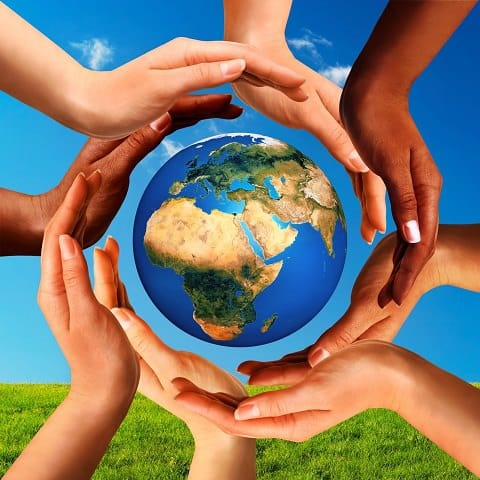Get an ecologist and an engineer in one room and watch the chemistry. It may sound strange, but this is exactly what happened when Geertjo van Dijk, Wavin’s urban climate adaptation expert, spoke with urban ecologist Marco Roos, urban ecologist at Naturalis. How can city and nature help each other? The three main conclusions they came up with are:
Conclusion 1: City trees are cut down “too early”
Biodiversity depends on three aspects: Safety, Nutrition and Reproduction. Organisms need all three if nature is to freely run its course. Considering this, city trees do not get the best chances. They are usually safe, but reproduction is not an option because municipalities want to decide where greenery is located in the city. Nutrition is also a problem: tree roots cannot easily penetrate compacted urban soil, and this causes them to grow insufficiently and absorb too little water. As Roos puts it: “A tree is just as big underground as it is above ground, if it doesn’t get the space it needs there, it can’t grow.”
Trees with roots that are too small pose a danger to people and buildings, which is why municipalities cut them down after about 35 years. But that is exactly the age at which trees actually start to absorb CO2 and become climate neutral. They only start to realise their greatest biological benefits after 35 years.
That’s why it’s a good idea to plant city trees in large underground “tree tanks” that contain soil with the right compactness and which can store rainwater for longer periods of time. This allows the roots to develop while simultaneously solving problems surrounding water shortage (which is a growing issue in many cities).
Conclusion 2: Cities should treat water like a nature reserve
The natural water cycle must return, especially in the artificial environment of the city. Traditionally, we have prevented flooding by directing rainwater out of the city as quickly as possible. This is not a bizarre idea though, because downpours and peak rain can quickly cause problems in the urban environment. But with weather becoming more extreme with more frequent heavy rainfall and longer periods of drought, water is going to become both a hazard and a precious commodity if we don’t change our behaviour.
Van Dijk: “Five of the ten driest months on record have occurred in the past 15 years. These droughts cause long-term health problems for flora.”
This is why we need to start thinking of cities as reservoirs. Just like in nature, water must be stored underground so it can be used during dry spells. This will act as a damper to the increasingly extreme conditions.
“Rainstorms and peak rainfall happen all the time, and have always done so. Take jungles for example, where it can rain very hard for a very short period, then stay dry for weeks at a time. This sort of behaviour only causes a nuisance in the city. But we should not try to dispose of the water straight away, we should ensure it remains available,” says Roos.
One way to do this is by installing smart underground water collection systems that store as much water as possible, but empty themselves when rain is on the way.

Conclusion 3: Treat the whole city as a nature reserve
People can tell the difference between nature and the city, but cities are just another landscape for plants and animals. This is how we should see it too.
We tend to need to create borders between greenery and buildings, but nature cannot be pigeon-holed like that, city and nature form one continuous ecosystem. Fortunately, we are learning to work in tandem with nature.
Roos: “On the one hand it’s all about balance: layout and structure, and on the other hand it’s about facilitating biological processes in order to achieve the most natural urban ecology possible.”
For example, the roofs of large commercial buildings are increasingly made “blue-green”: they store rainwater and plants grow on them. The next step is to create connections and generate a large, linked green zone in which plants and animals can move freely.
Another helping hand is to slope the banks of channels and canals instead of leaving them as unnatural vertical drop-offs. These will create mini-ecosystems in which plants and animals can thrive.
These are just two separate examples, but there are countless areas that can be looked at to generate gains.
Roos: “We really need to learn to think in terms of going with the flow instead of working against it.”
In cities such as Amsterdam, specialised teams are now taking a holistic view of plants and animals in residential areas. They know that a green city is almost literally alive.
Everything is interrelated: from urban planning to water quality, from biodiversity to animal welfare.
And that is perhaps the most important conclusion of the conversation between van Dijk and Roos:
The secret of the living city is the realisation that it is so much more than “just a city”.
It is a place that serves all organisms: people, animals, plants and even fungi and bacteria. Our biologist and engineer wholeheartedly agree.
About Geertjo van Dijk
Geertjo van Dijk is Global Product Manager for “Urban Climate Resilience” at Wavin. With his team, he develops new solutions for climate resilient cities and is responsible for the implementation of these systems in cities. His mission is to preserve our planet as a safe, healthy and attractive place for future generations.
About Marco Roos
Marco Roos works as an Urban Biodiversity researcher at Naturalis and is a Higher Education Coordinator and Biology Examiner at Leiden University. He spent many years researching ferns in the rainforest, but moved back to the Netherlands to focus on nature in the city. He organises biodiversity bike tours through the city, and regularly stands with his feet in the mud (and on the asphalt) to learn more about biodiversity in residential areas.